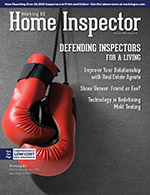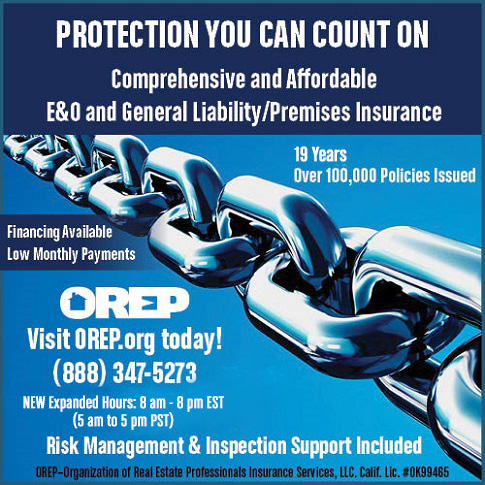 |
> E&O/GL Insurance for Home Inspectors Competitive Rates, Broad Coverage, Free Risk Management, online inspection support for tough questions, discounts on education and more... Professional Coverage, Competitive Pricing Shop OREP today! |
>> Editor’s Note: To help you stay up-to-date and connected, OREP/Working RE has established a Coronavirus (COVID-19) Discussion and Resource Page where you can share your thoughts, experiences, advice and challenges with fellow inspectors. See what Inspectors are saying here!
>> Take the Coronavirus: National Home Inspector’s Survey. Provide your industry feedback.
Technology is Redefining Mold Testing
by Ben Cahoon, CEO, Techcyte
Mold is all around us. In the past 25 years the scientific community has documented its impact on our health through many studies—now there is a technological advancement in mold testing worth noting.
In 1993, the Mayo Clinic reported that 93% of chronic sinus infections can be attributed to mold. According to the National Institutes of Health (NIH), mold exposure symptoms can include sneezing, nasal congestion or runny nose, wheezing and difficulty breathing, coughing, throat irritation, chest tightness, and skin rashes. Infants who are exposed to mold have nearly three times greater risk of becoming asthmatic than those who did not have extensive mold exposure in their first year of life.
The Center for Disease Control (CDC) recommends that people with asthma or other lung conditions—like chronic obstructive lung disorder (COPD)—should stay away from places where mold can be seen or smelled, even if they aren’t allergic to mold. The CDC also recommends that people with weakened immune systems—cancer patients on chemotherapy, those who have received an organ or stem cell transplant, and HIV patients—stay away from moldy areas.
Experts from the 2015 documentary “Moldy” even claim that environmental mold is much more dangerous to human beings than lead paint or asbestos. And most shocking is that estimates indicate that between 50% and 70% of homes in the U.S. have mold. With everything we know about mold’s impact on our health, mold testing should be a service every homeowner and homebuyer is interested in.
Big Opportunity
In the U.S. alone, over five and a half million homes are sold every year. When a property changes hands, it is common practice to have a home inspection performed. According to study conducted by the NAR (National Association of Realtors), 84% of homebuyers requested a home inspection as part of the purchase contract, and almost all Realtors (99% to be precise) recommend a home inspection.
However, only five percent of the five and half million homes sold every year are tested for mold. The impact of mold illnesses is staggering. Statistics for the U.S. show that the annual cost of allergic rhinitis caused by dampness and indoor mold is $3.7 billion. Water damage and mold cost the insurance industry $2.5 billion per year, and the average cost of a home water damage insurance claim is nearly $7,000. These statistics should result in a huge opportunity for home inspectors. Which begs the question: why aren’t more people asking for a mold test?
Home Inspectors and Mold Testing
Few home inspectors test for mold because testing requires training. Home inspectors can report on mold that they see but not the invisible mold. That requires the intervention of mold specialists. For the average home inspector, getting trained to perform mold inspections isn’t lucrative enough to make the investment worth it. Without training, home inspectors must refer the business, leaving some profit on the table.
Secondly, mold testing solutions take time. When homeowners make the decision to sell their home, many factors come into play. The average time for homes to close once they go under contract is one and a half months. Twenty-five percent of home sales get delayed during closing, and home inspections cause 16 percent of those delays, which ultimately results in over 110,000 home deals falling through. It’s a high-pressure process with a short timeframe in which to get a lot accomplished. On average, three to four days are required between the time mold samples are sent to a lab and the time the lab delivers results, which can be too long for a home inspection report to be delivered back to homebuyers if they are in a hurry.
Thirdly, mold inspections are expensive. Amidst all the other costs incurred with a home sale that can include staging and prep fees, real estate agent commissions, closing fees, title fees, transfer or excise taxes, escrow fees, reconveyance fee, recording fees, prorated property taxes, seller concessions, overlap costs, moving and relocation costs and a mortgage payoff, mold tests are just plain expensive. The average cost of a mold inspection is $650 according to Homeadvisor.com and Homeserve.com.
Contrast this with the average home inspection at only $400, where multiple areas are checked including heating systems, central air conditioning, interior plumbing, electrical systems, roof, attic, walls, ceilings, floors, windows and doors, basement and structural components. It puts the cost of a single mold test into an unfavorable light, which makes it understandable that home inspectors are not very motivated to offer it as part of their service.
While the reasons for not proposing more mold tests are understandable, the fact that over half of U.S. homes are infected with mold remains very real. As home inspectors, whose careers are built on giving homeowners the information they need to be sure their home will be safe and secure, our gaze turns toward potential solutions.
New Technology Brings About Important Changes
Over the past several years, new technology called “machine learning” (artificial intelligence) has emerged. One branch of artificial intelligence deals with images; more specifically, finding and identifying things in pictures. This can be pictures of people (face recognition), satellite images, medical imagery, or pictures from our mobile phones. It is being used in countless applications, from digitizing books to helping visually impaired people navigate and interact with their surroundings, to facial recognition for security, medical visualization, biometrics, self-driving vehicles, gaming, surveillance, law enforcement, and many others. Machine learning can basically do what humans do through observation (either with the naked eye or through a microscope), only it doesn’t get tired or distracted. While humans are excellent at pattern recognition, machine learning’s biggest advantages are the consistency and diligence by which it performs its job. It’s like having a few thousand eager young beagles, all hot on the scent of whatever they’re asked to track, and they search relentlessly, no questions
asked, until they find it.
One of the more advanced branches of machine learning uses “neural networks,” which resemble the way the human brain works: by making associations and trying different variations to a problem until it finds the most optimal way to solve it. Except that the computer can try thousands of variations, as opposed to humans who can only manage a few, and it can do it exponentially faster, cheaper, and more consistently.
(story continues below)
(story continues)
Very recently, this technology has been applied to the environmental air quality sector as well, taking air sample images on microscope slides, scanning them into digital form, and then analyzing and reporting on them. Whereas in the past these images would have arrived in a laboratory where a mycologist would spend painstaking minutes searching for harmful mold spores, today this can be done in a matter of seconds using machine learning.
With this advanced technology, home inspectors can screen for mold and get particulate counts with the same quality that they could expect from a lab, the next day—and at a fraction of the cost. Bringing the cost of the test down would make it feasible for home inspectors to offer the mold screen to many more homeowners, without the expensive training that today’s methods require. Because it is digitized, in addition to mold and particulate counts, the homebuyer would be able to see images of the actual spores and particulates in their home.
A home inspector’s main goal is to protect their clients and give them the information they need to make informed decisions about the homes they’re considering purchasing. As technologies like machine learning find new applications in indoor air quality, mold and particulate screening could become an invaluable tool in the home inspector’s toolbox.
About the Author
Ben Cahoon is a serial entrepreneur and for the past six years, he’s helped launch Techcyte working on everything from the product to projections, marketing, partnerships, and funding. Ben learned from air quality and mold perspective from one of the best mycologists in the nation, John Haines. Ben has a passion for digital mold spores and believes that AI will change the mold industry by providing more consistent results, quicker, and lower costs.
Tip for Mold Testing:
If you test for mold, it is a good idea to ask your E&O insurance provider if you have the proper coverage. OREP offers coverage for mold testing as a very inexpensive add-on to its base program. Call OREP at 888-347-5273 or your agent for details. If you want to learn more about this technology and how it works, visit sporecyte.com/homeinspector.
OREP/WRE Coronavirus Discussion and Resource Page
Coronavirus: National Home Inspector Survey
Free Risk Management Online Course Claims and Complaints: How to Stay Out of Trouble
Available Now
Presenter: David Brauner, Senior Insurance Broker OREP
David Brauner, Senior Broker at OREP, shares insights and advice gained over 25+ years of providing E&O insurance for inspectors, showing you how to protect yourself and your business. Watch Now!
Note: The Summer 2021 issue of Working RE Home Inspector is mailing now to over 25,000 home inspectors nationwide. OREP Insureds enjoy guaranteed delivery of each print magazine and many more benefits.


